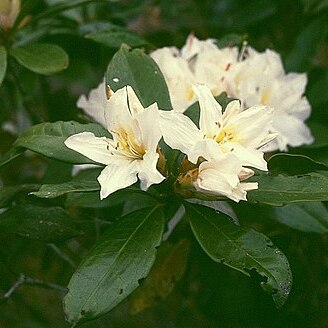Terrestrial shrub, 3-5 m, or small tree, with straight, erect branches. Branchlets glabrous, terete; internodes 2-8 cm. Leaves in ± terminal, 2-4-merous pseudowhorls, elliptic or mostly elliptic-lanceolate, rarely obovate-elliptic or oblong-oblanceolate, apex acute, base narrowed, ± coriaceous, glabrous, 6-12(-15) by (2.5-)3-5(-6) cm, midrib impressed above, much raised beneath, nerves 9-12 pairs, straight, spreading and ± parallel, initially slightly prominent or somewhat impressed, more conspicuously inarched in mature leaves above, prominent beneath, veins slightly or not visible; petiole often red in fresh specimens, somewhat winged, (6-)8—12(-15) mm. Inflorescences 2-4, each in the axil of one of the upper leaves; inflorescences 2-4-flowered. Floral buds ovoid-oblong, subacute, c. 2.5 by 0.8 cm. Outer perulae small and ovate, obtuse, inner ones gradually larger and ovate to ovate-oblong or obovate-oblong, all glabrous or rather faintly sericeous outside especially towards the tip, densely white-ciliate. Bracteoles linear, glabrous, up to 2.5 by 0.1 cm. Pedicels rather slender, glabrous, (1-)1.5-2.5 cm. Calyx very small, margin undulately lobed, glabrous. Corolla funnel-shaped, deeply 5-lobed, 3.5-4 cm long in all, tube 1-1.5 cm, base 5-saccate, 3-4 mm ø, lobes oblong, subacute, ± spreading, 2-2.5 by 0.5-0.9 cm, glabrous, mostly white with a yellow spot inside on the upper lobe, also rose or of a clear orchid-purple with a ± orange spot, rarely reddish, fragrant. Stamens normally 10 (sometimes a few more), ± as long as the corolla; filaments linear, hairy except the very base and upper half, occasionally entirely glabrous; anthers short-oblong, 2.5 by 1 mm. Disk glabrous. Ovary glabrous, cylindric, slightly 5-ribbed, mostly continuous (rarely abrupt) with the glabrous style, c. 3 cm long; stigma capitate. Capsule ovoid-fusiform, rather deeply 5 grooved, 2-2.5 by c. 0.6 cm, beaked by the persistent rest of the style even after the capsule is split into 5 rather thin, not twisted valves. Seeds flat, broad-oblong, very shortly and irregularly winged (not tailed) on both ends, c. 2 mm.
More
Shrubs or small trees, 3–15 m tall; bark gray-brown, not peeling. Petioles stout, 10–15 mm, glabrous; leaf blade leathery, oblong-lanceolate or elliptic-lanceolate, 5–12 × 2.5–5 cm; base cuneate or broadly cuneate; margin revolute; apex acuminate to acute; both surfaces glabrous; lateral veins not reaching margin. Inflorescence subapical, 2-or 3-flowered. Pedicel 1–2 cm, glabrous; calyx lobes 5, shallowly undulate, small, glabrous; corolla narrowly funnelform, white, with a yellow blotch within, 4.3–5.5 cm, tube 15–20 × 3–4 mm in diam., lobes deeply divided, spreading, oblong-obovate, apex entire and rounded; stamens 10, unequal, 3.5–4 cm, slightly shorter than corolla, filaments flat, with silvery-white scurfy pubescence below middle; ovary long-cylindric, tapering into style, 5–10 mm, dark brown, glabrous; style ca. 5 cm, often shorter than corolla, slightly longer than stamens, glabrous. Capsule cylindric, apex acuminate, 35–60 × 4–6 mm; style persistent. Fl. Mar–Apr, fr. Jul–Dec.
A shrub or small tree. It grows 3-15 m tall. The bark is grey brown and does not peel. The leaves are oblong to sword shaped and 5-12 cm long by 3-5 cm wide. The base is wedge shaped and the edges curl under. The flowers are in groups of 2 or 3 towards the end of branches. They are funnel shaped and white with a yellow blotch.


